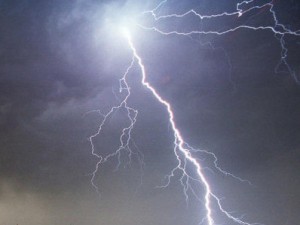 The old saying says not to mess with Mother Nature and she apparently wanted to drive that point home in Boston yesterday. During a live weather forecast on WBZ-TV yesterday a lightning strike knocked the lights out in the studio.
The old saying says not to mess with Mother Nature and she apparently wanted to drive that point home in Boston yesterday. During a live weather forecast on WBZ-TV yesterday a lightning strike knocked the lights out in the studio.
Thunderstorms rolled through much of the northeastern United States yesterday. The storms brought heavy rain, strong wind and plenty of lightning.
Ironically Chief Meteorologist Todd Gutner was discussing those exact weather conditions when the bolt hit.
Following the boom of thunder and a burst of static the lights went out and some of the displays flickered. Amazingly enough the station was able to continue broadcasting and Gutner finished his forecast, albeit a bit in the dark.
Check out the video below.




 The old saying says not to mess with Mother Nature and she apparently wanted to drive that point home in Boston yesterday. During a live weather forecast on WBZ-TV yesterday a lightning strike knocked the lights out in the studio.
The old saying says not to mess with Mother Nature and she apparently wanted to drive that point home in Boston yesterday. During a live weather forecast on WBZ-TV yesterday a lightning strike knocked the lights out in the studio.




